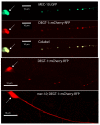Specific roles for DEG/ENaC and TRP channels in touch and thermosensation in C. elegans nociceptors
- PMID: 20512132
- PMCID: PMC2975101
- DOI: 10.1038/nn.2581
Specific roles for DEG/ENaC and TRP channels in touch and thermosensation in C. elegans nociceptors
Abstract
Polymodal nociceptors detect noxious stimuli, including harsh touch, toxic chemicals and extremes of heat and cold. The molecular mechanisms by which nociceptors are able to sense multiple qualitatively distinct stimuli are not well understood. We found that the C. elegans PVD neurons are mulitidendritic nociceptors that respond to harsh touch and cold temperatures. The harsh touch modality specifically required the DEG/ENaC proteins MEC-10 and DEGT-1, which represent putative components of a harsh touch mechanotransduction complex. In contrast, responses to cold required the TRPA-1 channel and were MEC-10 and DEGT-1 independent. Heterologous expression of C. elegans TRPA-1 conferred cold responsiveness to other C. elegans neurons and to mammalian cells, indicating that TRPA-1 is a cold sensor. Our results suggest that C. elegans nociceptors respond to thermal and mechanical stimuli using distinct sets of molecules and identify DEG/ENaC channels as potential receptors for mechanical pain.
Figures








Similar articles
-
Two novel DEG/ENaC channel subunits expressed in glia are needed for nose-touch sensitivity in Caenorhabditis elegans.J Neurosci. 2013 Jan 16;33(3):936-49. doi: 10.1523/JNEUROSCI.2749-12.2013. J Neurosci. 2013. PMID: 23325233 Free PMC article.
-
DEG/ENaC but not TRP channels are the major mechanoelectrical transduction channels in a C. elegans nociceptor.Neuron. 2011 Sep 8;71(5):845-57. doi: 10.1016/j.neuron.2011.06.038. Neuron. 2011. PMID: 21903078 Free PMC article.
-
Nanoscale organization of the MEC-4 DEG/ENaC sensory mechanotransduction channel in Caenorhabditis elegans touch receptor neurons.J Neurosci. 2007 Dec 19;27(51):14089-98. doi: 10.1523/JNEUROSCI.4179-07.2007. J Neurosci. 2007. PMID: 18094248 Free PMC article.
-
Mechanotransduction: touch and feel at the molecular level as modeled in Caenorhabditis elegans.Mol Neurobiol. 2007 Dec;36(3):254-71. doi: 10.1007/s12035-007-8009-5. Epub 2007 Sep 27. Mol Neurobiol. 2007. PMID: 17955200 Review.
-
Mechanosensory molecules and circuits in C. elegans.Pflugers Arch. 2015 Jan;467(1):39-48. doi: 10.1007/s00424-014-1574-3. Epub 2014 Jul 23. Pflugers Arch. 2015. PMID: 25053538 Free PMC article. Review.
Cited by
-
High-Resolution Imaging and Morphological Phenotyping of C. elegans through Stable Robotic Sample Rotation and Artificial Intelligence-Based 3-Dimensional Reconstruction.Research (Wash D C). 2024 Oct 30;7:0513. doi: 10.34133/research.0513. eCollection 2024. Research (Wash D C). 2024. PMID: 39479356 Free PMC article.
-
Two novel DEG/ENaC channel subunits expressed in glia are needed for nose-touch sensitivity in Caenorhabditis elegans.J Neurosci. 2013 Jan 16;33(3):936-49. doi: 10.1523/JNEUROSCI.2749-12.2013. J Neurosci. 2013. PMID: 23325233 Free PMC article.
-
Multiparameter behavioral profiling reveals distinct thermal response regimes in Caenorhabditis elegans.BMC Biol. 2012 Oct 31;10:85. doi: 10.1186/1741-7007-10-85. BMC Biol. 2012. PMID: 23114012 Free PMC article.
-
Deep learning-enabled analysis reveals distinct neuronal phenotypes induced by aging and cold-shock.BMC Biol. 2020 Sep 23;18(1):130. doi: 10.1186/s12915-020-00861-w. BMC Biol. 2020. PMID: 32967665 Free PMC article.
-
X-ray induces mechanical and heat allodynia in mouse via TRPA1 and TRPV1 activation.Mol Pain. 2019 Jan-Dec;15:1744806919849201. doi: 10.1177/1744806919849201. Mol Pain. 2019. PMID: 31012378 Free PMC article.
References
-
- Wemmie JA, Price MP, Welsh MJ. Acid-sensing ion channels: advances, questions and therapeutic opportunities. Trends Neurosci. 2006;29:578–86. - PubMed
-
- Caterina MJ, et al. The capsaicin receptor: a heat-activated ion channel in the pain pathway. Nature. 1997;389:816–24. - PubMed
-
- Tominaga M, et al. The cloned capsaicin receptor integrates multiple pain-producing stimuli. Neuron. 1998;21:531–43. - PubMed
-
- McKemy DD, Neuhausser WM, Julius D. Identification of a cold receptor reveals a general role for TRP channels in thermosensation. Nature. 2002;416:52–8. - PubMed
Publication types
MeSH terms
Substances
Grants and funding
LinkOut - more resources
Full Text Sources
Other Literature Sources
Research Materials

